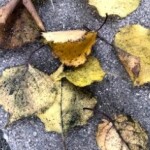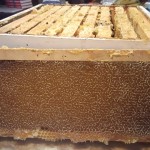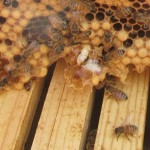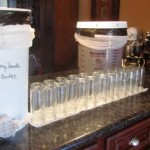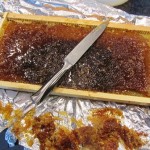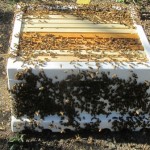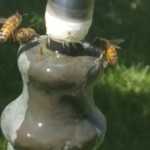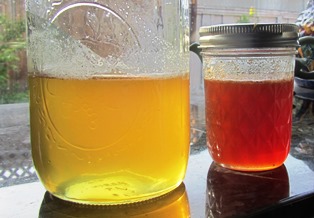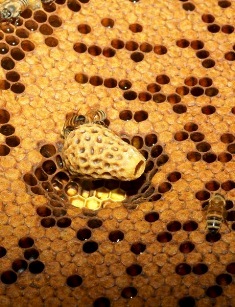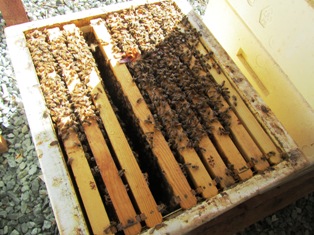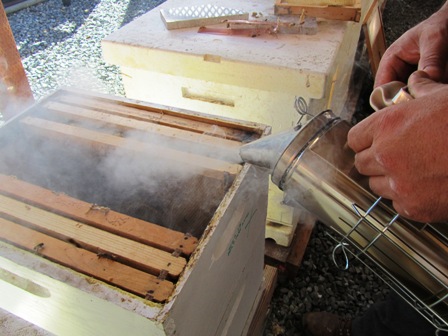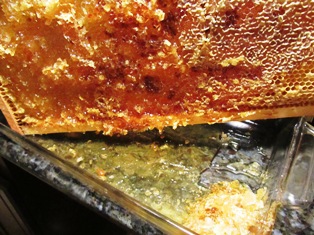Worst Apricot Aphids Ever
The farmette apricot trees have been shedding leaves as winter approaches. I’ve recently noticed ants in the tree and leaves that are sticky. Further investigation revealed that the tree leaves are covered with apricot aphids seeking moisture and nutrients from the leaves.
The local garden center’s expert explained that those tiny aphids know when the seasons are changing. As leaves fall, they take in nutrients to tide them over to spring. Ants often signal a pest problem with the tree long before you notice the presence of aphids.
Like many pests attacking apricot trees, aphids overwinter as eggs (smaller than a grain of rice). These eggs are hidden in the cracks and crevices of the bark, branches, and twigs.
During this past fall (2021), aphids flew around our apricot and other fruit trees like ash on a windy day. They consumed leaf and stem sap that resulted in a sticky substance known as honeydew, a sticky waste product left on the leaves.
It’s worth mentioning that aphids aren’t the only apricot tree pests. A partial list of other apricot tree pests includes:
1. mealybugs
2. earwigs
3. mites
4. leaf roller
5. apricot-peach twig borer
6. scale
7. spider mites
Although we don’t like using any kind of spray out of concern over toxicity to our honeybees, our local garden center recommends using an organic spray such as Captain Jack’s (approved for organic farming). This time of year, it’s a good idea to apply the spray after pruning the trees.
Doing a good job with pruning and spraying means that the aphids might not be such a problem come spring.
____________________________________________________________________________
Enjoy reading about farm topics? Check out my Henny Penny Farmette series of cozy mysteries. Chocked full of farm trivia and helpful advice for keeping chickens and bees and growing heirloom fruit and vegetables, all three novels are available online and in bookstores everywhere.
A Beeline to Murder–When the town’s celebrity pastry chef is found dead, Abby Mackenzie (a former cop who supplies the chef with her organic lavender honey) discovers the chef’s secret private life suggests the killer might be local.
The Murder of a Queen Bee–The botanical shop owner and friend of Abby Mackenzie doesn’t make it to a party where she’s the guest of honor. Her death leads Abby to speculate that friends of the deceased might be hiding her killer.
A Hive of Homicides–Abby attends a vow-renewal party of her best friend and is an ear witness to the murder of the newly arrived re-married couple. The husband’s philandering past establishes a pool of suspects but Abby is convinced that there’s more to the murder a scorned lover’s revenge.
Harvesting Honey–Helping Hands Always Welcome
When it comes to opening the hives of honey bees here on our farmette, I’m grateful for the helping hands of my hubby and my neighbor. Carlos, my hubby and helpmate for life, is my go-to guy for all our farm projects. And our neighbor Peter not only has answers to my questions about bees, but also he can open a hive, remove frames of honey, inspect and medicate, and seal the unit lickety-split.
With the smoker at the ready and lit, we opened our hives September 23, 2018. The hives were robust, but the bees appeared stressed. I had added supers to each hive in late July but should have kept a closer eye on the burgeoning bee population. They had become overcrowded and hungry.
For harvesting, we first removed the heavy metal lid of the hive box, replacing it with a fume board. A fume board is a lid lined with fabric that is sprayed with a product that encourages the bees to vacate the supers (some bees immediately leave the box; others go into the brood chambers). The fume board works within seven to ten minutes. We then pulled out the frames of honey, gently brushed off any remaining bees, and took the honey-heavy frames to the kitchen.
For an old hand at beekeeping like my neighbor, the process went quick. Not so for me. This past year, I injured both my shoulders with tears in the rotator cuff tendons. With limitation to some of my range of motion, I’ve felt pretty handicapped. Still, I helped by carrying a single frame of honey at a time from the hive box to the kitchen.
While the hives were open, we removed old medicated strips previously hung in the boxes to thwart mites.
- Small sheets for trapping hive beetles are placed across the frames in the top super before closing the lid
We also replaced the Bee-Gone sheets to trap hive beetles. It’s important to properly handle such items and to keep the apiary clean. We put in medication for mite control–a white gelatinous substance spread on a paper similiar to an index card. Finally, we placed a single patty of bee food on the frames to provide for the bees’ nutritional needs.
The bees immediately coalesced on the patty; no longer stressed, they seemed gentle and calm. Checking the bottom frames, we found a lot of brood (eggs, larvae and pupae of bees). To help this new generation of honey bees along, we inserted an unopened frame of honey that I’d kept wrapped in foil and frozen (freezing kills any insects that could infect the hive or bees). Honey, of course, is the perfect food for them.
We will reopen the hives in two weeks and re-check the status of the bees. A that time, we’ll treat with an antibiotic for winter and possibly add a super if necessary.
I haven’t yet processed the honey we harvested but the frames are on my kitchen counter. They are in a hive box wrapped in aluminum foil. At the ready are also several food-grade buckets that I’ve carefully washed, dried, and covered with lids. The honey spinning machine has been cleaned. Before I begin working with the honey in the frames, I always scrub my kitchen, washing the countertops twice–first with soap and water and then with diluted bleach and hot water.
When everything is clean, I will begin to work on each frame. I first scrape away any bee “glue” from the outside edges of the frame. With a hot knife, I slice all around the interior edges before opening the sealed wax cells (sliding the hot knife just under the wax and lifting). Both sides of the frame are dealt with in this manner. After the wax cells are uncapped, the frame will be placed into the spinning machine. It uses centrifugal force to spin off the honey. The sweet stuff then drains through the strainer material taped around the bucket mouth. The bucket is positioned under the machine spigot.
My reward for this labor of love is having an abundance of sweet, amber honey when desired to bake a honey cake or other culinary creation, to enjoy a relaxing cup of tea, or to fill jars for holiday gift-giving. Beekeeping draws people together and, take it from me, a helping hand is always appreciated.
_______________________________________________________________________________
If you enjoy reading about keeping bees and chickens, growing heirloom vegetables and fruits, or living the farmette (small farm) life, check out my offering of books that tie into themes of living well and close to the Earth.
Grab one or more of my cozy mysteries (no gratuitous sex, profanity, or violence) and discover delicious farm recipes, gardening advice, and tips for caring for bees and chickens.
Or pick up one of my wellness, spirituality, or manifesting books. They make great holiday gifts for yourself and others.
All my books are available in traditional bookstores everywhere and also online at Amazon.com, Barnes & Noble (barnesandnoble.com), Kobo Books, Walmart, and other retailers.
For more information, click on the following URLs:
A HIVE OF HOMICIDES
MURDER OF A QUEEN BEE
A BEELINE TO MURDER

More than 150 rituals for sound mind, strong body, and meaningful connections to the people around you
https://www.amazon.com/dp/B0719HHVRJ/ref=dp-kindle-redirect?_encoding=UTF8&btkr=1
A Hive of Homicides or Hive Demise
The title of the third novel in my Henny Penny Farmette series suggests loss of bees and murderous intent. No beekeeper wants to lose a hive, regardless of how it happens–whether some invader wants to kill the bees, go after the honey, or use the hive as a host for proliferation of its own species.
I’m not one-hundred percent positive why I lost a hive this year. My best guess was that the demise was due (not to homicide but rather) to a tiny little pest, possibly a beetle that weakened it so that the bees and queen fled leading to the hive’s demise.
My beekeeper neighbor and I spotted a small beetle and treated for it. My best efforts to keep my small bee house and the area around it clean as well as doing frequent hive inspections wasn’t enough. Now, I’m considering moving my remaining hive onto a higher, drier, sunnier location.
I’ll do it at night which is the correct time to move bees. You just put a little strip of packing foam along the hive entrance, gently move the hive, and place it in the new location. Remove the foam strip so the bees can leave at dawn and make sure there’s a water source nearby.
The bees will likely accept the move if there is water and food in the area. I like planting perennial bee gardens and flowers and bulbs with high nectar value for bloom throughout the year.
Since hives can be compromised by wax moths, hive beetles, and other pests (as well as parasites and diseases), frequent inspections to decipher a problem and treat it before it destroys your hive is imperative.
With supers (smaller hive boxes with ten frames each) on the hive in June, the bees will forage on abundant flowers and produce honey that can be taken off in July. That’s also the time to inspect for mites because these populations tend to swell during summer.
________________________________________________________________
If you’re interested in beekeeping and other farmette topics, check out my Henny Penny Farmette series of mysteries. All are available to order online at Amazon, Barnes and Noble, and other retailer sites as well as traditional bookstores everywhere.
Preparing Honeybee Hives for Spring
Recently, I conducted a mid-winter check of my honeybee hives. With my beekeeper neighbor’s help, we opened my Henny Penny Farmette Hives A and B to search for signs of an increase in the mite population, the presence of other pests, and evidence of mold. Inspecting and treating bees with medicines when necessary are important bee management practices.
We found one bug that I couldn’t identify but my neighbor explained it lays a narrow worm and must be removed before its numbers increase. This we did. We also found three frames in Hive B that had a few spots of mold. We threw away the frames and replaced them with wax-covered frames in the lower hive box where the queen had already produced lots of bee babies.
There appeared to be adequate stores of honey, baby bee food, and lots of baby bees. In fact, we removed a few frames of honey from both hives. In their place, we inserted frames that previously had the honey drained off but wax left intact (these I always freeze before putting back into hives since freezing kills mites, larvae, and wax moth), making it easier for the bees to start building comb.
The honey I harvested is dark-colored and earthy tasting, typical of autumn honey when the bees collect pollen from eucalyptus, star thistle, and other sources available in autumn. In contrast, spring honey is light-colored and slightly citrus tasting from pollen gathered from blooming citrus trees and wildflowers.
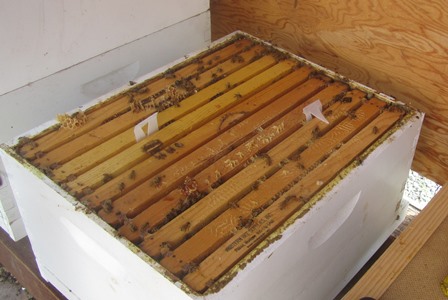
Hang medicated miticide strips between frames inward from the edge of the hive box for mite control.
Since we found evidence of mites, we hung miticide strips between frames to combat tracheal and Varroa mites. Also, we sprinkled powdered sugar medicine (Tetra-Bee Mix 2X Medicated) over the frames to control risk of American foulbrood. Treating the hives thus will enable the bees to remain robust. I expect their numbers to swell with warmer weather which, in turn, translates to new swarms in the spring.
*Apivar is an effective treatment of Varroa mites. One strip per four to five frames works through contact and should be placed in high bee activity areas. Not to be used when honey supers (top hive boxes with frames of honey) are on.
*Tetra-Bee Mix 2 X Medicated is recommended for control of American foulbrood caused by paenibacillus larvae and European foulbrood caused by streptococcus pluton susceptible to oxytetracycline in bees when used as directed.
For more beekeeping tips, delicious recipes, and a wholesome whodunnit, check out my Henny Penny Farmette cozy mysteries: A BEELINE TO MURDER (paperback release in October 2016), MURDER OF A QUEEN BEE (hardcover October 2016), and HIVE OF HOMICIDES (October 2017). Find them on Amazon.com, Barnesandnoble.com and other online and conventional bookstores everywhere.
Why Use a Screened Bottom Board in the Hive?
When beekeepers see signs that the population of Varroa destructor mites are increasing in the hive, they will take action to reduce the mite population. One way they can track mite levels is by using a screened bottom board.
A close monitoring of a screened bottom board can give a beekeeper a good idea of whether or not the mite population is increasing or decreasing in the hive.
Mites fall through the screen to the ground. A screened bottom board stretches across a platform that the hive box sits on.
When the mites in a hive fall on solid bottoms in a hive box, they can ride back up into the interior of the hive on other bees. A great article for building your own screened bottom board can be found at http://www.michiganbees.org/wp-content/uploads/2012/03/Screened-Bottom-Board_20110324.pdf
The use of a screened bottom board prevents bees returning upwards in the hive. One sign of mites at work in a hive are wings missing from newly emerged baby bees. There are other signs as well.
For lots of interesting bee “stuff” as well as farming tips and delicious recipes, check out my newest novel, A BEELINE TO MURDER.
Now available online and from brick-and-mortar bookstores everywhere. See, http://tinyurl.com/p8d6owd
Put Your Eyes and Nose on Your Hives
As a beekeepeer, I sniff my hives as well as visually examine them for signs of hive health. A healthy hive smells pleasant but an unhealthy one can emit a foul odor.
This time of year, honeybee hives should be checked for populations of mites. Especially destructive is the Varroa destructor mite and the tracheal mite. Mite populations can rapidly increase and decimate a hive.
The Varroa destructor mites are true “blood suckers” and feed on adult bees (especially drones or males) and baby bee larvae.
I inspect for deformed bees (like wings missing), red or brown spots on bee larvae, or pinpoint-size mites (looking like ticks) clinging behind a bee’s head or between its abdominal sections. It’s best to treat immediately when the signs are clear that there’s a problem in the hive. If it smells foul, there could be an infection.
In fact, beekeepers need to stay vigilant for all kinds of illnesses that can harm their hives: mites, bacterial infections, and/or even predators placing hive’s health at risk.
The scent of honey and the hum of bees busily working inside the hives can be reassuring to a beekeeper, but doesn’t eliminate the need for regular inspections, especially in autumn. You want your hives to be healthy enough to make it through whatever conditions winter brings.
For bee tips, recipes, and a killer cozy mystery, check out my newest offering: A BEELINE TO MURDER. See, http://tinyurl.com/ptegs9g
Ants in the Freezer . . . Seriously?
Well, this is embarrassing. I found ants, a big pile of them, in the bottom of the freezer side of my double-door fridge. I thought it was a mound of spilled coffee grounds. But that made no sense. Why would ants venture into the freezer in the first place. Crazy as it seems, I have an idea.
A few weeks ago, my beekeeper neighbor told me about a little trick to sterilize frames before putting them into the hives. He said after I have drained a frame of honey, I should hang it outside in a tree near the hives for the bees to clean (they will eat the honey but leave the wax).
Then, I should put the frame of wax in a freezer so that any tiny pest like the larva of a wax moth or mites or ants will be killed.
After 24 hours, I can remove the frame from the freezer and store it until I’m ready to put it into a hive box. When I harvest honey, I can easily replace a honey-filled frame with an empty frame that has been sterilized in the freezer and already has beeswax. It’s less work for the honeybees to use that frame for brood or honey. Sounds good, right?
Well . . . I wrapped two frames with aluminum foil before putting them in the freezer. But I got lazy and just inserted one frame into the freezer without first wrapping it. It seemed very clean–just white wax left by the bees after they had devoured all the honey.
The unwrapped frame I put in my kitchen freezer must have leaked a drop or two of honey that I didn’t see. It drew those ants. Serves me right.
Now I have a designated freezer to be used only for honeybee frame sterilization. It will stand outside on my patio. I’m pretty sure the ants won’t be visiting my kitchen again. At least, that’s what I’m hoping.
The Seductive Taste and Smell of Honey
The sweet, seductive scent of honey permeates the rear of my property where the honeybee traffic has picked up now that we have had a few warm days. My neighbor Peter told me on Saturday that we would open the hives today. I enjoy helping him with bees, and my organic yogurt wouldn’t taste the same without that sweet honey drizzled on top.
Peter says it’s coming on winter now and the bees need food. Sources of pollen diminish during fall and winter. Our inspection will determine whether or not the bees and their hives are in good shape. Most likely, if there is honey, we won’t harvest it but rather leave it for the bees. Still . . . if there’s an abundance, we might take a frame or two.
When he was just a boy, Peter received his training as a beekeeper from his father. His father’s honeybees kept their Lebanese village supplied with honey. Our purpose in opening the hives today is to inspect the physical structures of the hives for mold, mites, ants, or any foul smell that might suggest a problem.
We last medicated the bees during the first week of October. This morning, the bees were so docile, Peter didn’t even suit up. But I did. Even so, the last time I put on the head-to-toe bee suit and the elbow length leather gloves, I still got stung as I was removing the suit.
At approximately 9:30 a.m. , we started to open the hives, smoking each one, in turn and closely checking each frame. The hives all looked healthy and robust. We removed spent containers of Apigard and the hanging sticks of antibiotic.
After inspecting each frame in each hive, we re-medicated the bees to ward off mites and anything that might attack or weaken the immune systems of the bees. The goal is to keep them healthy and strong so that the honeybees survive with their babies through the winter to swarm in the spring (swarms are the way the bees expand their populations).
The last three hives were particularly strong. The bees were busily working. Each super (styrofoam box or hive that holds ten frames) was heavy. We reduced the sizes of the hives to two supers instead of a stack of three on top of each other. Smaller hives during the winter means less work for the bees to stay warm and make babies.
Peter handed me three frames of honey to take to my kitchen. He also took a frame or two. Tomorrow, I’ll make a honey cake . . . if I can stop myself from constantly sampling the gorgeous colored, sweet tasting honey that slowly drips from the frames into large glass dishes in my kitchen.
 Facebook
Facebook Goodreads
Goodreads LinkedIn
LinkedIn Meera Lester
Meera Lester Twitter
Twitter






